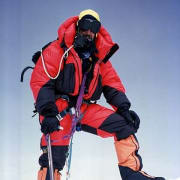Last Survivor of 1953 Mt. Everest Team Talks Crowds and Waste

Everest Climbing Permits Decrease in 2024
In 2023, a record 478 climbing permits were issued - all by the Nepalese government as the North route via Tibet was closed to foreign climbers. 2023 was also the deadliest climbing season since 1953, as 19 climbers were reported missing or dead. There was a slight decrease in the number of permits issued by the Nepalese government in 2024, down to 421 climbing permits. The permits were issued to 345 males and 76 females on 45 separate teams. Additionally, there were permits issued to 500 Nepalese climbers.
Though fewer climbers attempted Mt. Everet this year, crowds remain a major concern relative to safety and accumulating waste. Five climbers were confirmed dead this year on the mountain, and three remain missing and are presumed dead. On a positive note, of the approximately 900 people vying to summit Everest this year, it is believed that approximately 600 climbers, including 200 foreigners, reached the summit.
There are no limits on the number of permits issued through Nepal, which accommodates the insatiable and growing demand to climb Mt. Everest. The China-controlled North-side route through Tibet reopened this year for the first time since 2019. This will fuel more climbing traffic on the mountain, though China limits the number of their climbing permits to 300.
Safety and Waste Concerns on Everest
With the record number of climbers currently traveling to Mt. Everest's North and South side basecamps, officials have scrambled to improve safety and minimize waste and unsanitary conditions. To curb the waste problem, for the first time climbers were required to pack out their waste (poop) in special bags issued by government officials. We don’t yet have a report on the efficacy of the ‘poop program’.
Much has been written about safety concerns relative to the mass of climbers ascending and descending the narrow and steep routes on Mt. Everest. This issue remains troubling as the governments of Tibet and Nepal have done little to limit permits. To improve safety, they are instituting a new rule to at least know where all of these climbers are. Mt. Everest climbers are now required (2024) to wear a tracking device throughout their climb.
The Last Survivor Discusses the Problem
KANCHHA SHERPA. Sir Edmund Hillary, from New Zealand, and his Sherpa teammate Tenzing Norgay were the first climbers to successfully summit Mt. Everest (29,029 ft.) on May 29, 1953. Hillary's team consisted of 35 climbers, all responsible for different tasks. One of those team members was Kanchha Sherpa, now 91 years old.
Kanchha Sherpa is the last surviving climber from this historic team, and was one of 3 Sherpas that labored to set the now-famous route to the highest camp on the Southeast side of Mt. Everest. Without permits to go higher, Kanchha Sherpa bid farewell to Hillary and Norgay, and prayed for an auspicious journey as the two departed for Mt. Everest's summit to make history.
Kanchha Sherpa is concerned. He was recently interviewed in Kathmandu, and shared his thoughts on Mt. Everest, or Qomolangma - the Goddess Mother of the World. (Reported by Binaj Gurubacharya in a Seattle Times Article) "They should not be dirtying the mountain. It is our biggest god and they should not be dirtying the gods. Qomolangma is the biggest god for the Sherpas but people smoke and eat meat and throw them on the mountain." He noted that Mt. Everest is now overcrowded, - "The world’s highest peak is too crowded and dirty, and the mountain is a god that needs to be respected. It would be better for the mountain to reduce the number of climbers. Right now there is always a big crowd of people at the summit.”
Mt. Everest is Crowded
Since Hillary's famous feat in 1953, 11,996 climbers (6,664 different climbers) have reached the summit of Mt. Everest, and the overall traffic has taken a dramatic toll. Over 330 climbers have died since Sir Edmund Hillary's expedition. Climbers, and their support crews, generate trash and waste which is often not carted off the mountain as required.
To protect the Goddess Mother of the World we need to regulate and restrict climbing permits, and monitor and enforce existing rules and traditions. Beyond regulation, we need to exhibit respect when climbing this iconic mountain by leaving it better than we found it.
